Austin Heritage Tree Foundation
Protecting trees
Protecting trees
Green GWTP
5 Additional Heritage Trees Were Saved Due To The Community (09.20.14)
The final chapter of the Green Redevelopment happened months ago with a bittersweet ending
Be proud of having helped saved these 5 heritage trees. These are the heritage trees that the community saved along with the Austin Heritage Tree Foundation, Camilla Freitag, the Environmental and Urban Forestry boards, CM Kathie Tovo, the City’s Arborist Office and the Economic Growth Office.
Trammel Crow voluntarily redesigned the building to accommodate the 2 larger heritage trees by Cesar Chavez, giving them sufficient room, and the 3 heritage oaks in the right of way along San Antonio, that the City allowed be removed to place a driveway. Unfortunately, the developer removed 2 heritage trees and one protected tree: The beautiful heritage oak in the lot and the heritage pecan in the northern Block One, and the protected public tree in the right of way (sidewalk) at San Antonio St.
The Austin Heritage Tree Foundation worked for months with the City's Economic Development Office and the Arborist office to convince the developer to let the community transplant the heritage oak, but Trammel Crow's Adam Nims didn't allow it last September because he didn't want to encumber the land and risk any delays to get the project's financing.
It's sad when we look back because there could have been a chance to save this heritage oak. It took the developer longer than anticipated to get the financing, so there would have been enough time to raise the money and transplant this heritage tree...but coulda, woulda, shoulda never account for much...at the end, the developer removed this heritage oak tree but voluntarily preserved 5 additional heritage trees on site by incorporating them into the design, as the Heritage Tree Ordinance mandates.
The developer didn't have to abide by the Heritage Tree Ordinance because the contract with the City was signed 2 years before it became effective. To preserve the additional 5 heritage trees, the City released the developer from the requirement to provide 2K square feet of public safety office and another 5K square feet for nonprofit uses. These were not quite enough to cover the redesign cost and lost of rentable space, but the preserved heritage trees added value to the development.
Saving these trees is expected to reduce the City’s expected property tax and sales tax from the development by $3.1 million over 30 years, or about $103,000 per year. Well worth it, according to many city officials, which have taken many steps to keep Austin green.
02/06/14 http://www.urbanspacerealtors.com/blog/downtown-development-digest-green-water-treatment-redevelopment.html
02/05/14 http://www.trammellcrow.com/EN/o/austin/Media-Center/Pages/City-of-Austin-Closes-on-Green-Water.aspx
02/05/14 http://www.statesman.com/news/business/apartment-tower-to-kick-off-green-water-redevelopm/ndDxT/
08/13/13 http://www.bizjournals.com/austin/blog/at-the-watercooler/2013/08/city-inks-31-million-deal-over-green.html?page=all
05/15/13 http://downtownaustinblog.org/2013/05/15/first-phase-of-green-water-construction-moving-forward/
05/25/12
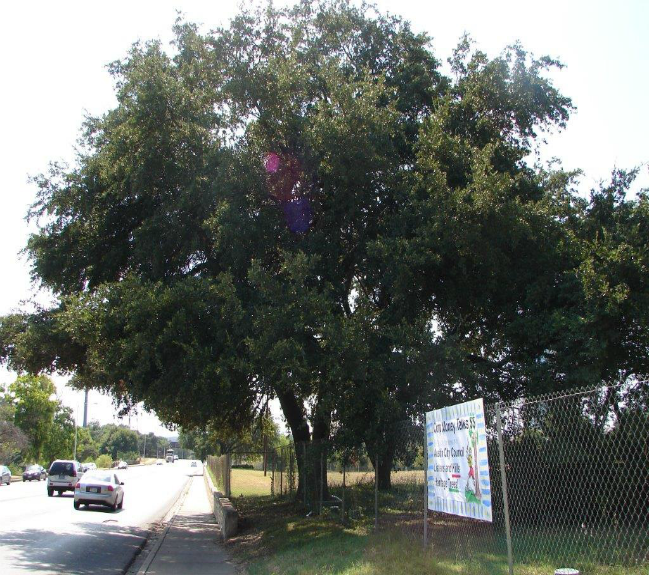
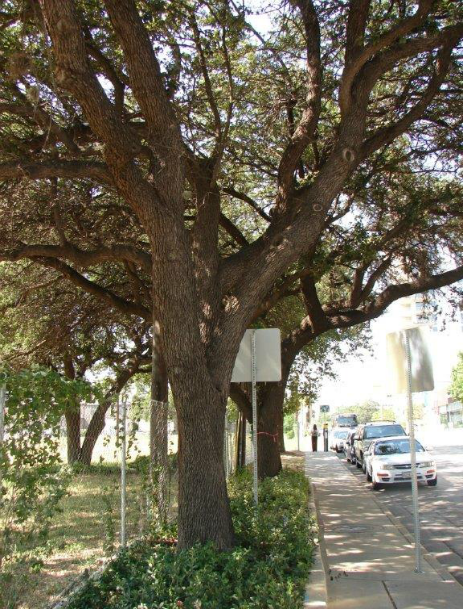
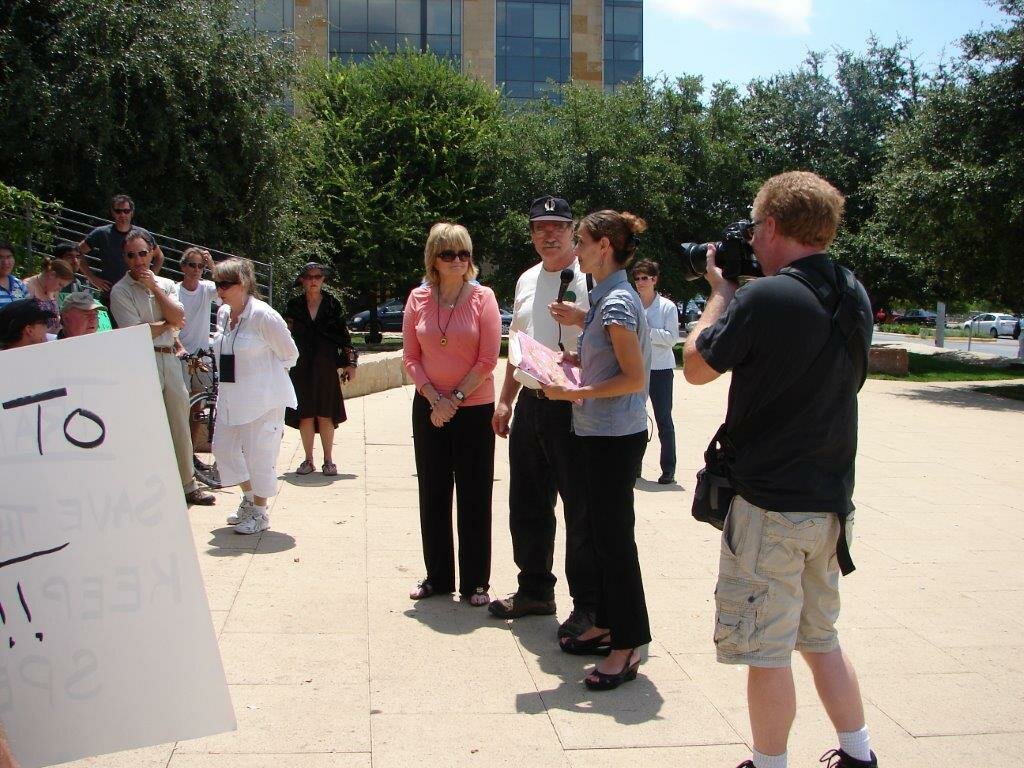
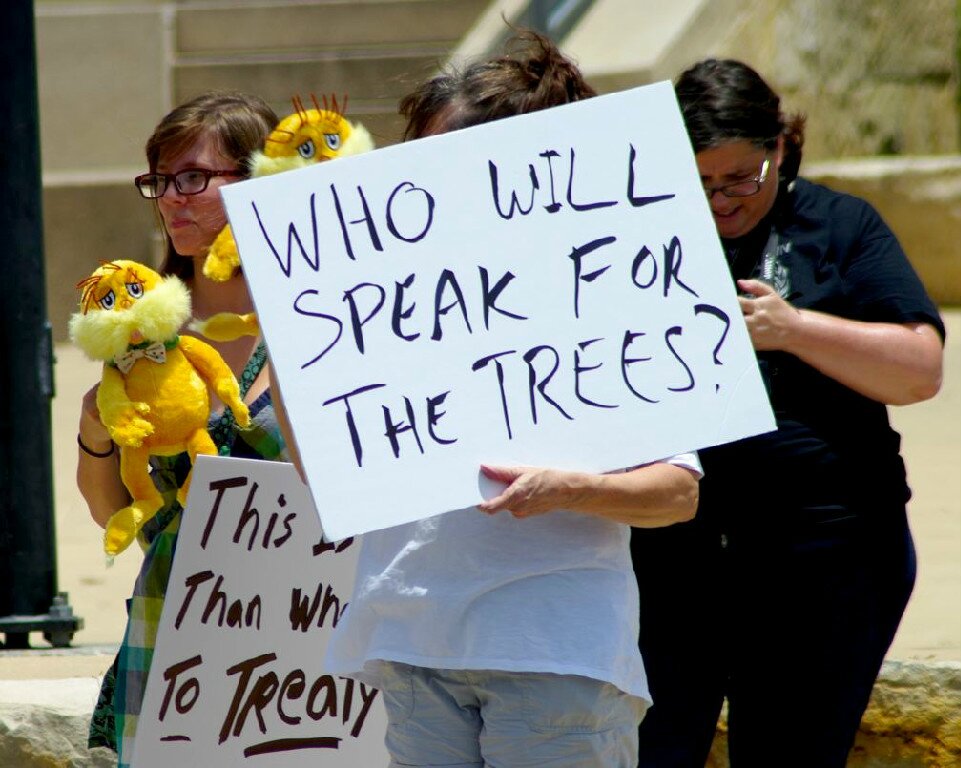
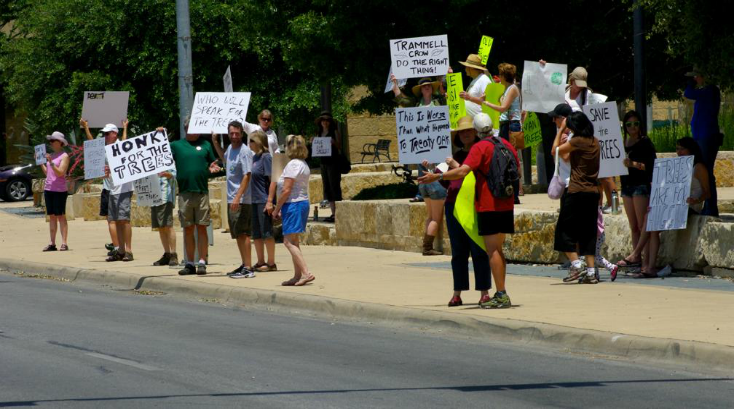
ARCHIVES - 2012
SAVE THE 7 TREES AT THE GREEN PLANT REDEVELOPMENT!
Please, sign this petition to save these trees.
Petition has over 3000 signatures: change.org/petitions/save-austin-s-trees
Facebook:
Twitter:
Process used for city council to decide waiving the heritage tree ordinance for the 6 heritage trees at the Green Plant Redevelopment: Click here for the staff presentation and Tree Study done by Trammel Crow on which the decision to waive the heritage tree ordinance was based.
THE TREES CAN BE SAVED AND ARE NOT THE POISON PILL THAT WILL KILL THIS DEVELOPER'S DEAL!
We will appreciate your help to save 6 heritage trees and 1 protected tree that will be removed at the Green Water Treatment Plant by Cesar Chavez when Trammel Crow develops the site soon. See the difference with Thanos's innovative pest control. On 05.24.12, Austin's City Council APPROVED A WAIVER TO BYPASS the Heritage Tree ordinance and remove these 7 trees. Mayor Lee Leffingwell said that requiring that the heritage tree ordinance be followed was the poison pill for the deal!
PLEASE, SAVE THESE TREES
Only 5% of the tree population in Austin is heritage trees, while a healthy forest should have at least 10%. There aren’t that many heritage trees left especially downtown. Heritage trees are the workhorses of the urban forest. It’s crucial for the community that City Council and the City respect the Heritage Tree Ordinance and preserve every heritage tree that can be preserved. It’s important that the developer at least tries to save the trees and works with the City Arborist and the community.
HERITAGE TREE ORDINANCE (HTO) GOAL
The goal of the HTO is to preserve heritage trees. Mitigation should only be considered after all efforts have been made to preserve the heritage trees on site by integrating them into the design, or if that can’t be done, by transplanting them.
WHY DID CITY COUNCIL WAIVE THE HTO FOR THIS DEVELOPMENT?
City council unanimously approved waiving the HTO, with CM Tovo's amendement to direct the City Arborist to work with Trammel Crow to try to incorporate the trees in the design. was not supported by the Mayor who said that saving the trees would be the poison pill for the deal.. The approved amendment provides direction, but it is NOT a requirement, and therefore is weak.
The HTO provides flexibility and does not stop development, but the City’s process was not followed by the City. The City Arborist Office was not involved, the applicant did not submit a tree removal permit, and the City Arborist Office did not approve the removal of these trees.
All the decisions were made by the Economic Growth Services Office and the City Manager's Office for Development, bypassing a process that the City itself has required over 2000 developers and about 800 homeowners to follow since the HT was approved. After the deal was done and the HTO was waived, City Manager Marc Ott thanked Trammel Crow for being so patient .
CAN ALL OR SOME OF THESE TREES BE INCORPORATED INTO THE DESIGN BY TRAMMEL CROW?
We are certain that it can be done if Trammel Crow were to try and have some flexibility. The City can help by providing variances or waivers, etc. Trammel Crow prides itself of being a company that cares for trees. We know that they can do it. These trees are all perfectly located at the perimeter of the site. Two of the trees by San Antonio are right by the sidewalks and are part of the ROW. The HTO provides help to accomplish this goal by requiring the applicant to apply for variances, exemptions, waivers, etc, that could help preserve the trees. If this cannot be done, there is always the option of transplanting the trees. It’s only after nothing else can be done that mitigation should be considered.
ALL OF THE TREES AT GREEN CAN BE TRANSPLANTED
Transplanting some or all of these trees should only be considered after it’s determined that some or all of these trees can’t be incorporated into the design. All of these trees are healthy and in good form. NONE of these 6 heritage trees and 1 protected tree are “too old or fragile to be transplanted”.
The City Arborist testified during the 05.24.12 city council meeting that all of the trees are healthy. The City Arborist explained that some of the trees may not be as good transplant candidates as others because they are close, or there are uncertainties about whether or not there are utilities below, and if there are utilities indeed, about whether or not the utilities would interefere.
These are concerns that need to be investigated, and are not absolute statements that discard the transplanting option for some of the trees. Trees that are close can be transplanted together.
WHY DIDN’T ANYONE SPEAK FOR THE TREES WHEN THE RFP WAS DEVELOPED IN 2008?
The Protected Tree Ordinance has been in place since the 70s. Why didn’t the RFP include “abide by the Protected Tree Ordinance”?
THERE IS NO LEGAL GRANDFATHERING BY THE RFP. THIS IS A VOLUNTARY WAIVER APPROVED BY CITY COUNCIL
City Legal explained to city council that the RFP is not binding, that they didn’t have to approve the waiver, and that there was no grandfathering.
WHY DID CITY COUNCIL APPROVED THE WAIVER?
Because Trammel Crow said that they looked at alternative designs, and saving the trees would reduce the footprint and that would increase costs, that will cause a significant reduction in affordable housing. Trammel Crow explained that with all of the other constraints in the contract, they couldn’t afford to save the trees. But, the data and alternative designs were not shared with city council.
In addition, there was never a discussion of what the city could give to the developer to facilitate saving the trees, like variances, exemptions, fees waived, etc. Sue Edwards, City Assistant Manager for Development, assured City Council members that they (Trammel Corw and her office) had worked for months looking at alternatives, and the trees couldn’t be saved. She also said that the City Arborist had been involved and walked the site, even that same morning. However, the City Arborist testified that he had NOT been involved in the process and had not approved any tree removals.
CM Martinez was very concerned that even accepting CM Tovo’s alternate amendment to direct the City Arborist to work with Trammel Crow to incorporate trees in the design, even just a weak direction, would require a variance to the Waterfront Overlay ordinance, something that other council members wouldn’t support either. But, there is no need for a variance to the Waterfront Overlay ordinance because it applies only to the 2 buildings facing Cesar Chavez, and because there are other design alternatives.
However, there are NO ALTERNATIVES if there is no discussion or attempt to save the trees, NO ALTERNATIVES if the trees are considered expendable, not valuable, and easily replaceable with mitigation money and young mitigation trees that don’t survive in our current harder climate conditions, poor soils and inadequate soil volume.
THE CITY INTENDED TO SAVE THESE TREES BECAUSE THEY PROTECTED THEM
DURING THE PLANT DEMOLITION AND IRRIGATED THEM FOR 4 YEARS
While the city removed 47 trees on site during the plant demolition in 2009, the city protected these 6 heritage trees and the 1 protected tree with wooden planks (per city code) and irrigated with above ground irrigation since then. Obviously, the City protected these 7 trees for 4 years.
Why does the City approve a waiver to remove these trees now when all of that money has been spent to protect them and water them for years?
PUBLIC PROCESS FOR 1 HERITAGE TREE WAS WAIVED AS WELL
The 33 inch pecan tree in the north east side of the lot qualified for a public process, where a variance is required from the Planning Commission after a review by the Urban Forestry Board and the Environmental Board. All of these public processes were bypassed with the waiver.
The city’s offices negotiating the development deal explained that the soil is contaminated and they have done tests, but the data is not available to the public. There is no proof that any contaminated soil extends to the pecan tree. In fact, evidence shows the contrary. Healthy trees like this pecan don’t grow in contaminated soil. And even if the soil had some contamination, a portion of the root zone of this tree could be excavated carefully to remove the contaminated soil. There is no need to remove this tree due to these unproven concerns.
MITIGATION CAN'T REPLACE HERITAGE TREES
It’s good to mitigate trees that are removed but only after it has been demonstrated that nothing else can be done, which in this case has not occurred. Mitigation is being offered under the pretense of satisfying the heritage tree ordinance.
Mayor Leffingwell and a couple of city council members discussed during the 05.24.12 city council meeting that, according to them, the ordinance was being followed except for the procedural part. But, the procedural part is the heart of the ordinance. It provides the oversight for the process so that these tree removal decisions are made by a qualified person from the City Arborist Office, and only after the required and agreed upon process is followed.
The HTO process was bypassed by city council approving the waiver, and city council accepted the mitigation that had been negotiated by the City offices brokering the deal. The mitigation rate set by the city is too low for heritage trees. City council was told that the proper mitigation rate per ordinance was applied but there is no breakdown of how it was calculated, the only information available is in the contract itself (pasted at the end of this post) showing a total of about $58K for 3 of the trees. That’s about $20K for tree (in average), which is too low for a heritage tree.
Administrative mitigation for heritage trees is too low in city code. A heritage tree would appraise at $40-50K or more, without including the historical and community value. Mitigation for the other 3 heritage trees is with 324 caliper inches of new trees.
Many new trees don’t survive in spite of irrigation because of climate change, poor soil and insufficient soil volumes, weak nursery trees with girdling roots, etc. Street trees, in average, don’t live longer than 10 years downtown and 15 years everywhere else in town. These trees wil be planted in parks, so the city will incur the cost of watering them for 3 years and caring for these trees for the rest of their lives.
Trammel Crow explained to city council that they will be spending $600K in mitigation. How do they come up with that number?
CM Riley’s only input during the waiver meeting was that the new young mitigation trees be planted near to the site "to respect the intent of the heritage tree ordinance to maintain canopy". However, the goal of the HTO is to preserve heritage trees, and canopy is NOT maintained with young trees that seldom survive to become heritage trees.
CM Riley also requested that the new young mitigation trees be planted nearby, as suggested to him by a local HOA, and defined "nearby" (to Cesar Chavez) to include Shoal Creek, Duncan Park and Pease Park, that are 15 blocks away.
CM Riley says that he is willing to talk to any group that would like to find ways to salvage the wood of these heritage trees for local building, farming or gardening projects. However, the community is outraged and tree lovers would rather talk about how to preserve these irreplaceable trees!
AHTF tries to re-use the wood of heritage trees to give a meaning and dignity to their ending, but only after everything has been done to try to save them, NOT when the ordinance is being waved, NOT when the trees are healthy, NOT when the developer has not tried to design to incorporate them in the design with some flexibility, NOT when the city has not tried to work with the developer to reduce some of the constraints or grant some density bonuses or incentives to make facilitate saving the trees, and certainly NOT when the trees could be transplanted.
These trees are being removed for convenience of the city’s office negotiating the deal, and under the fear that Trammel Crow will walk away from the deal...for convenience and to make things easier for the City and the developer, at the sake of these irreplaceable historical heritage trees!
____________________________________________________________________________________
This ordinance was approved by City Council waiving the Heritage Tree ordinance
Sections 25-8-641(B) (Heritage Tree Removal Prohibited) and 25-8-642 (Heritage Tree Variance)
"Developer’s satisfactory performance of its obligations under this paragraph will be deemed full and complete compliance with the Ordinance."
<
This Master Development Agreement was approved by City Council
It specifies that the 6 heritage trees and 1 protected tree be removed, and 1 heritage tree be transplanted, waiving the Heritage Tree ordinance with the waivers described above (no administrative or public variance):
<
After the issuance of the RFP, submittal of the RFP Response and selection of the Developer, the City enacted Ordinance 20100204-038 (the “Ordinance”), commonly known as the Heritage Tree Ordinance. The Property currently has seven “Heritage” trees (Tree Numbers 1184, 1370, 1371, 1385, 1386, 1412 and 3018) and one “Protected” tree (Tree Number 1430), each as defined in the Ordinance, which are delineated on Exhibit B attached hereto.
In connection with the Environmental Remediation during the City’s ownership of Block 23, Tree Number 3018 will be removed and mitigated. Prior to the development of Block 185, Tree Number 1184 will be transplanted to a location agreed upon by City and Developer near the Property. Not later than the Commencement of Construction for Block 1, Developer shall pay to the City the total sum of $58,632 concerning the removal of Tree Numbers 1370, 1371 and 1430. In connection with the development of Block 1, Tree Numbers 1385, 1386 and 1412 will be removed and mitigated with new trees (or an increase in the minimum caliper of onsite Great Streets Development Program’s trees), or a combination thereof, of at least 324 caliper inches to be installed at the appropriate time in the next growing season but within 9 months of the Commencement of Construction on Block 1.
Any “transplanted” trees required under this paragraph will include a five year Developer irrigation and maintenance commitment. Any “new trees” required under this paragraph will be located in City of Austin public parks as selected by the City and reasonably approved by Developer in as close a proximity to the Property as possible, be at least 4” caliper trees, be a variety which is listed as a potential future “Heritage” tree in the Ordinance and include a two year Developer warranty and irrigation commitment for all trees not located on the Property. Developer’s satisfactory performance of its obligations under this paragraph will be deemed full and complete compliance with the Ordinance.>>
